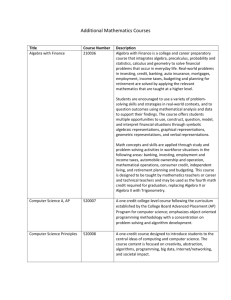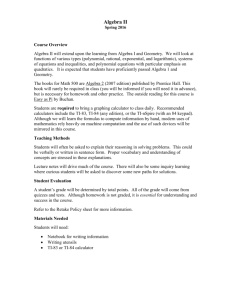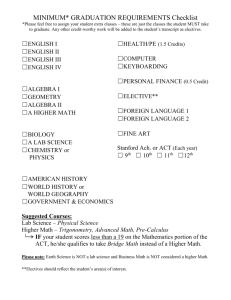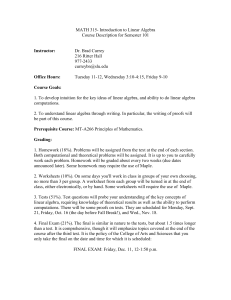paper_Melissa_Linear Algebra
advertisement
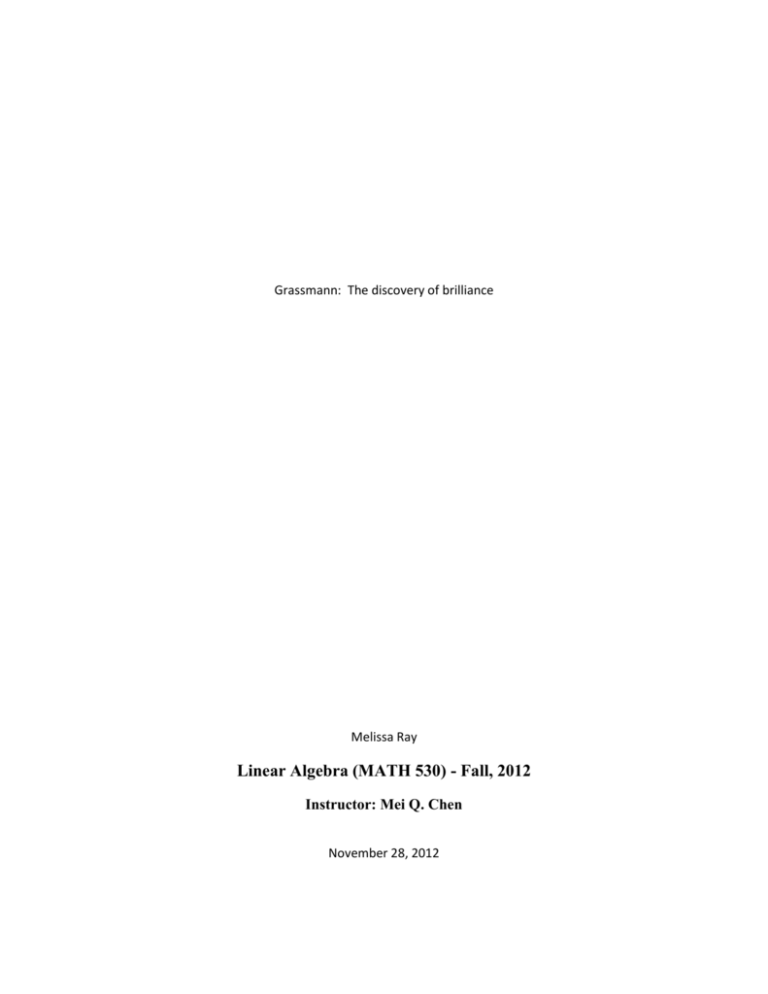
Grassmann: The discovery of brilliance Melissa Ray Linear Algebra (MATH 530) - Fall, 2012 Instructor: Mei Q. Chen November 28, 2012 I. Introduction Mathematics seems to have grown out of the minds of incredible people who had a natural curiosity to solve the most perplexing issues in life's travels. While mathematics seems to be an everevolving field with countless men and women that have taken the field to a new level, for some, it is a matter of perplexing curiosity spurred by individuals close to them. Brilliance begins with stimulation of some sort. Unfortunately, this brilliance can also be disregarded due to the inability to comprehend the brilliance and ingenuity of the early Mathematicians. Hermann Gunther Grassmann was one of these early mathematicians that aggressively pursued the study. Grassmann was born the third son of twelve children born to Justus and Johanne Grassmann April 15th, 1809 in Stettin, Prussia. Grassmann's Father, Justus Gunther Grassmann, was a teacher of mathematics and physics and wrote several textbooks of standard level mathematics. Grassmann seemed to be searching for his parents' approval in his life choices. It appears his mother's father was a minister. As the family was extremely religious, Grassmann's first education was that of a minister with an emphasis on linguistics. After experiencing the university education of theology, literature and languages, he later returned to mathematics. Because he could only teach the elementary age, he took the examinations to move up to secondary education (bookrags). It seemed as Grassmann's first initial desire was to be in a field of study that was pleasing to his parents. II. Grassmann's contributions to Linear Algebra Much like any field, at times when such an amazing mind creates or discovers greatness, the world of his or her time fails to see or even have the ability to understand the concepts discovered. Throughout history, there are many great minds who were persecuted or dismissed for their findings. The story of Grassmann is, unfortunately, no different. In 1842, Grassmann published Die Lineale Ausdehnungslehre in which he stated mathematical concepts above and beyond the natural understanding of the time. Grassmann wanted to follow in his father's footsteps and exceed his father's stance. Mathematics is to be void of emotion. The black and white, simple and complete absolute, with explanation and exploration, any concept can be proven or disproven. This is very different than the humanistic aspect of the ones that discover the truth behind the mathematics. Grassmann has been termed the "founder of Linear Algebra" or "inventor" of the basis for linear algebra, especially in the applications to Geometry (Fearnley-Sander). "In an arithmetic text published in 1861, he defined the arithmetic operations for integers inductively and he proved their propertiescommutativity, associativity, distributivity (pg. 810, Fearnley-Sander)." As the father or inventor of Linear Algebra , he combined the geometry intermixed with the algebra to create a new and different perspective. Unfortunately, Grassmann's concept of vector space, or more clearly stated today, as Linear space, came into mathematics when Hermann Weyl and others developed formal definitions. Grassmann never formally defined the concept of vector space, this is the reason that Peano was very comfortable with Grassmann's work and became published off Grassmann's concepts and work. Peono was able to make clearer the concepts that Grassmann did not have the language developed to explain (Fearley-Sander). Most of Grassmann's research was completed alone with the occasional assistance from Mobius, Hankel, and Clebsch. Grassmann's work: Die Lineale Ausdehnungslehre was not written in verbage most mathematicians of the time expected. His philosophical logic was bound to the first chapter and skipped by most reading the information. Thusly, the abstract concepts within the book failed to be recognized or understood by the mathematics community of his time (Hestenes). As these concepts were so abstract and unable to be clearly stated in a form of language understood, it seems Grassmann's contributions were not discovered. Later, Grassmann's algebra is defined as Geometric Algebra. In other articles it is also referred to as Projective Geometry. Either way, the application of vectors, space, subspace and dimensions are grand and vastly a concept founded by a man ahead of his time (Schulz). "Grassmann is a pivotal figure in the historical evolution of a mathematical language to characterize human understanding of the physical world. Since quantitative concepts of space and time are fundamental to the understanding, the language is fundamentally geometrical and can best be described as geometric calculus." (Hestenes). Grassmann's biggest known contribution would be the definition of the vector addition and the scalar vector multiplication that is today a vastly accepted concept. Unfortunately, the concept of congruence with the vectors being in different directions and or magnitudes being considered congruent through a transformation matrix was not thoroughly understood or proven until long after Grassmann's death (Zaharia). As the concepts of Linear Algebra began to form, there was much difficulty introducing the concept of more dimensions to the matrix multiplications and create the associative rings within the greater dimensions. Grassman named this concept as an "inner product" and represented it as a "dot" b giving the ability to determine orthogonal projection when a is considered b then multiplied by the length of b. Grassmann provided the Distributive, Commutative and Scalar Commutative properties of the matrices within his writings. It was found that the inner product is not associative as found with the other properties of standard multiplication (Zaharia). The inner product is only just the beginning of Grassmann's algebra. Grassmann also defined the "outer product" as well and this was to designate the dimensions of the geometric space and to assist in defining the subspaces. The "outer product" was found to have associative, distributive in addition, and commutative scalar multiplication properties as well as anticommunitive and anti-symmetric properties exist within the matrix outer product for coplaner vectors (Zaharia). Grassmann research emphatically focused on the abstract algebraic properties of the products, but failed to reach the importance on the geometrical meanings. A gentleman by the name of William Kingdon Clifford expanded on Grassmann's principles to the geometric level and thus founded the Clifford Algebra. Clifford Algebra, also known as Geometric Algebra, sees that the three dimensional space can be obtained through adding the scalars, vectors, bivectors and trivectros all called multivectors to form subspaces. It also presents "geometric Algebra of the 3d Euclidean Space." (Zaharia). It was also believed that Grassman also tested these properties towards the end of his life, but unfortunately, there is not a formal publishing to review. Clifford repeatedly stated his basis was formed upon that presented by Grassmann, but this life was cut far too short to be able to properly communicate how much of the Clifford Geometry was founded by Grassmann (Hestenes). Finding the proper language and use for Grassmann's geometric algebra, Clifford assisted in bringing out Grassmann's thoughts and making them more comprehensible concepts. III. Linear Algebra's initiation to the mathematics arena Hermann Weyl reignited the Linear Algebra mentality in the 1920's as he formed a formal definition of the mathematics based on Peano and Grassmann's work as Grassmann and Peano did not have available terminology to define the mathematical concepts. Weyl helped to distinctly describe the Grassmann ideal and reopened Euclidean principles with a twist (Fearnley-Sander). This initially brought the expanse of knowledge and broadened the understanding of Linear Algebra and Physics. As Clifford expanded on Grassmann's concepts, the later towards the twentieth century, Grassmann's algebra was noted as a rival for physics. Contradictory to this notion, the mathematics of Oliver Heaviside and Hamilton's reflect very closely to sections of Grassmann's research. Moreover, Grassmann's and Clifford's Geometric Calculus takes the required four Maxwell Equations of Heaviside and allows them to become one single equation. Dieudonne states that Grassmann's concepts are the more accurate and grander than the other ideas and the more "dominant 'Modern View'" (Hestenes). "The remarkable result is that every linear transformation on the base space can be represented in this algebra as a monomial product of vectors" (Hestenes) . Grassmann's mathematics was so advanced as to be the father of linear algebra and the simplification of Physics. IV. The uses of Linear Algebra Initially, the first uses of Linear Algebra was to transform geometric objects and the solutions of systems of linear equations. As Linear Algebra has grown and changed, not only has linear algebra assisted with geometry, the concepts are used in branches of physics, used in Graph Theory, Theory of Games, The Leontief Model in Economics, Forest Management, Computer Graphics, Computer-assisted Tomography, Genetics, Cryptography, Electrical Networks, and Fractals (Ottawa). These uses are now considered fundamental and the main use of Linear algebra is for data mining and dissemination in all of these items, as well as, finding correlations and patterns. IV. Conclusion Grassmann may not have followed completely in his father's footsteps as he only fathered nine children and never achieved the Educator status is father held, but as with many, the proof of his brilliance came after his death. While Grassmann never really receives the recognition in the early mathematics peer groups, the modern day mathematicians recognize how modern and advanced Grassmann's mentalities were. Grassmann's father would be extremely proud to know his son's works founded the beginnings of most computer graphics and will impact the future of mathematics forever. Works Cited Bookrags.com, "World of Mathematics on Hermann Gunther Grassmann". Web 6 October 2012. Fearnley-Sander, Desmond., "Hermann Grassmann and the Creation of Linear Algebra". maa.org. Web 1 October 2012. Hestenes, David., "Grassmann's Vision". Geocalcl.clas.asu.edu., 1996 (Gert Schubring, ed.), Kluwer Academic Publishers, Dordrect/Boston 191-201. Web 1 October 2012. aix1.uottawa.ca/~jkhoury/matrices.html, Web 16 November 2012. Schulz, William C., "Theory and application of Grassmann Algebra". Transgalactic Publishing Company. Flagstaff, Vienna, 31 August 2011 . Web 1 October 2012. Zaharia, Marius Dorian. "Computer Graphics from a Geometric Algebra Perspective". Intelligent Autonomous Systems. Netherlands. Web 1 October 2012.


